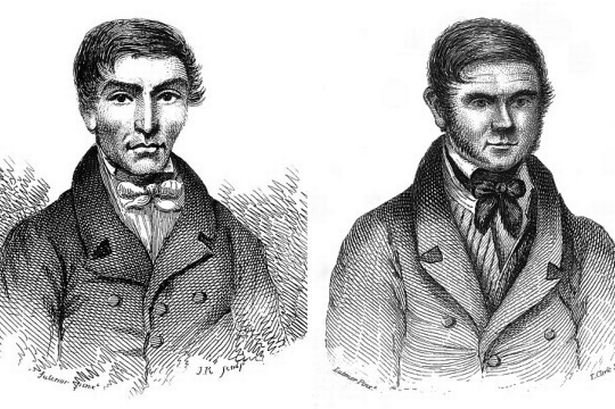The story of the Burke Hare Murder Dolls starts with a series of murders committed in Edinburgh, Scotland in the late 1820s. The mystery of the murder dolls begins around the same time and continues until this day. It is a strange tale that may have some connection to the guilt or sadistic obsessions of one of the killers.
Not long after a series of murders took place in Edinburgh, Scotland, a boy found an interesting group of dolls in coffins. They found the dolls in a cave on Arthur's Seat at Holyrood Park in Edinburgh. Initially, the dolls appeared odd, but did not seem to have any significance beyond their oddness and the location in which they were found. Over time, it became obvious that they were very similar in number and appearance to the victims of the recent killing spree.
William Burke and William Hare were two Irishmen who met in Scotland and became friends sometime in the 1820s. Hare ran a boarding house with his wife. There, in 1828, one of the tenants died of natural causes. Burke and Hare sold the body of the man to a doctor at Edinburgh University to be used as a medical school cadaver.
At the time, the medical schools had a shortage of bodies to use for dissection. They were only allowed to use executed criminals and criminals were being executed less frequently. Doctors were sometimes resorting to purchasing bodies from so-called body snatchers or, more accurately, grave robbers. It appears that one Dr. Knox of the University of Edinburgh was not averse to purchasing the bodies of murder victims, either, though it is not absolutely certain that he was aware of the fact when he started doing it.
After selling the body of the deceased tenant, Burke and Hare realized that they could make a living off selling the bodies of the dead. They were making less than the equivalent of 1,500 USD in modern currency per body, but that was enough to compel them to kill 16 individuals. Many were killed by smothering, though one was given a medication overdose and a little boy had his back broken. Eventually, a tenant found a body underneath a bed at the boarding house and turned the pair into the police. The body was gone by the time the police got there. However, Hare made a deal and told all in exchange for his freedom. Burke was executed and dissected publicly and several of his body parts, included a death mask of his face, were saved.
The dolls discovered in the cave numbered 17. They also appeared to represent each of the bodies sold to Dr. Knox -- who was not charged with any crime. The dolls are roughly 4 inches long each and have their own individual coffins. Dating puts them around the same time as the murders and many assume that one of the killers is responsible for carving the dolls. Modern DNA testing conducted on the body of the Burke and on the dolls found no connection, but that is because there was nothing to find on the dolls after all this time.
If indeed the dolls were made during the killings, only a handful of people could have done the carving. There was Dr. Knox, who likely knew the cadavers he was purchasing were murder victims. There were Burke and Hare, Hare's mistress and Burke's wife. Dr. Knox's brother possibly knew as well, but there were almost certainly no more people who could have made the dolls. One of these people could have made the dolls out of guilt. Of course, one of the killers could have made the dolls as souvenirs and stashed them in the cave when the murders were discovered. Hare could have made them after Burke's murder trial and stashed them as well. If they were made after the murders were discovered, it could have been anybody.
There are currently only 8 of the original 17 murder dolls left. They are kept at the National Museum of Scotland in Edinburgh. The dissected remains of one of the men who killed the people the dolls reportedly represent -- Burke -- are kept at the University of Edinburgh.

No comments:
Post a Comment